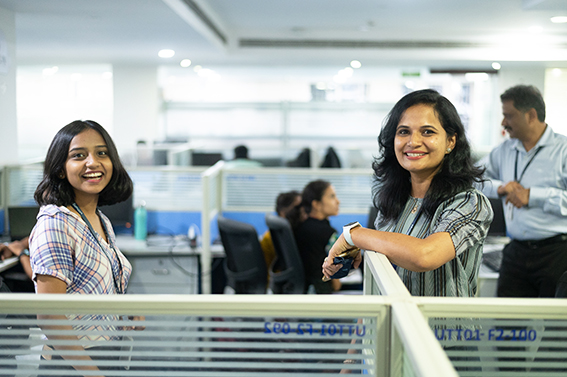Smitha Rao’s dream is to build another Infosys, as Sudha Murthy has been her muse. As a woman in the STEM field, Rao capitalised on her passion for technology and her entrepreneurial skills to co-found Utthunga Technologies in 2007. She is an industrial automation domain expert specialising in the OPC UA and device integration areas. At Utthunga, she heads Europe Sales and the OPC Business vertical.
With 15 years of experience in the field, Rao feels that the arena has changed a lot vis-a-vis its perspective on women in the STEM fields. And her own company is setting an example by having most of the leadership roles helmed by women and by providing 40 per cent of their workspace to females.
Interacting with SME Futures, she opens up on her journey and how it has changed her.
Edited excerpts:
Can you tell us about your family background and what you wanted to become while growing up?
I was born to a business family in a small town – Ranebennur of Karnataka. My grandfather started a cycle shop called ‘Jai Bharath Cycle Store’ in 1940 and this business ran for more than 60+ years. So, discussing business strategy and customer experience was a part of our day-to-day life.
My father is my role model as he always believed in taking calculated risks and standing for his values. He has built his own empire with business ethics, values etc. He always told me to give my 100% with good intentions and leave the result to destiny. Apart from him, my mother supported me unconditionally throughout my studies and even now, she is my backbone, and she ensures that I handle my family, my work, and my passion with ease.
As a child, I was a bright student and believed in giving my 100 per cent to everything that I did. I was inspired by Sudha Murthy who hails from my district called Shiggaon. She was my role model and I always wanted to be like her. She has inspired me a lot as a value-driven, passionate woman. As a child, I wanted to join Infosys, but now I want to build one.
Tell us about the most common obstacles that women face in the STEM fields. Please tell us about your own experiences as a female leader.
As per a report, women make up only 28 per cent of the workforce in the STEM fields and this percentage gets even lower as we move up the ladder. However, it has improved over the last few decades.
Mastering the STEM fields requires a lot of dedication and focused effort. Even the women with the required interest and skills tend to lose their focus as they move up the ladder in the workspace. Multiple factors contribute to this trend, like bias, the societal environment, family responsibilities etc. A man compromising his career growth for his wife’s career is an exception, whereas the other way around is the norm.
Taking a break from a high paying job to get a master’s degree is still not as common for women. She would have already lost a few years of her career in managing the kids and again while taking a break to sharpen her skills to be ready for bigger games, which is not common. In most scenarios, it’s more to do with a woman’s belief in herself than societal conditions. Women tend to give it up and take a backseat instead of taking the plunge to make their mark.
Talking about myself, in most conferences and events that I have participated in across the globe, I could see only a few women (the ratio is around 1:20). However, I soon realised that it does not matter as long as I bring value to the table.
It also helped me to gain more confidence. Another challenge that women face is to successfully manage their careers, their families and their passions. To handle these things with ease, we women need to build a supportive ecosystem around us. In the pre-COVID era, I used to travel for 4-5 months a year (2-3 weeks at a time) and I have 2 kids. It was a challenging time, and I am grateful to my mom, my husband and my caretaker for their support.

What differences have you noticed between then and now, as more women enter the STEM fields?
A few decades ago, women in STEM were considered to be the exception to the established norm. In one interview, Sudha Murthy has mentioned that she was the only female in her engineering class. However, this has changed for good in the last few decades.
Today, women are no longer confined to household chores, and society has accepted that they can contribute equally to the financial aspect of their families. Nowadays, in school, they teach kids about cooking and managing household chores irrespective of their gender.
At the workplace, as a leader, there will always be a dilemma on being well-liked vs taking correct, but difficult decisions. And women tend to face more challenges while taking the right, but tough decisions as compared to men. It is always believed that women are tender, fragile and caring. Taking a tough decision at the workplace is contradictory to this social bias. However, overcoming these, and putting in additional effort and focus towards contributing to the growth of the organisation can change the game and alter the perceptions about women in leadership roles.
At Utthunga, most leadership roles are helmed by women and 40 per cent of the workforce is female.
How has your entrepreneurial journey thus far helped you evolve as a person?
I have evolved as a person for good in this entrepreneurship journey. You can inspire people to listen to you only when they believe that you are working for their good. Ensuring that your team is growing is an important part of the entrepreneurship journey and that means that you always need to put your team’s interests ahead of your own comfort zone, and interest is the key here.
You suggested Sheryl Sandberg’s book ‘Lean In Women, Work and the Will to Lead,’ Why? What are the takeaways for aspiring entrepreneurs from this book?
Sheryl Sandberg’s book has really helped me to come to terms with the challenges that women face in managing both career and family. I can recollect below 3 points from her book:
Believe in yourself: Even though women are highly skilled and competent, when it comes to business negotiations and decisions, we tend to hold back and rely on others to make the decisions. I experienced this myself and realized that it was me who was holding myself back, rather than anyone else. I then changed my thought process to constantly learn new things, which allowed me to enter uncomfortable zones, and slowly coming out of these gave me strength and confidence. With this, I have learnt that instead of saying, “I am not ready to do this “, I will now confidently say – “it’s just a matter of time and effort, and I will do it”.
A career path is not a ladder, but a jungle gym: It is often believed that one’s career path is like a ladder (as reflected in statements such as “Climb up the ladder”), i.e., a one-directional and upward journey. However, in reality, especially in an entrepreneurship journey, it is a zig-zag path. While most of the initiatives that you take as a leader may not yield results, whether you are still exhibiting leadership qualities, even when things are not going well, shows your resilience. And this can improve with constant learning. Being aware that failure is not the opposite of success, but a part of it gives you the freedom to try new things.
Make your life partner a real partner in your career aspirations: Managing both career and family at the same time can be extremely challenging for a woman. It’s not possible unless we have a supportive ecosystem around us. One’s husband’s play an important role here and making them our true partners is crucial. This requires good understanding and focused efforts towards taking the relationship to the next level. Sharing your day-to-day happenings and conversations about each other’s weaknesses and interests will help.
What are the plans for your company down the line?
We have big plans for Utthunga for the next three years. The past 14 years have been an exciting and challenging journey for us. We wanted to be a niche player in the industrial automation domain for our product, solution and service offerings. We wanted to increase our market presence and build our engineering teams in the USA, Europe, and Japan. We will increase our offering portfolio and our revenue in the next three years and gear up for inorganic growth.











